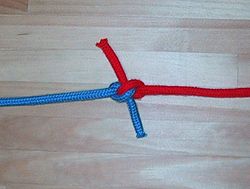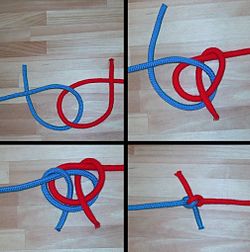Difference between revisions of "AY Honors/Knot/Hunter's bend/es"
From Pathfinder Wiki
< AY HonorsAY Honors/Knot/Hunter's bend/es
(Created page with "Libro de Respuestas de Especialidades JA/Nudo/Cazador") |
(Updating to match new version of source page) |
||
| (6 intermediate revisions by 2 users not shown) | |||
| Line 1: | Line 1: | ||
<noinclude></noinclude> | <noinclude></noinclude> | ||
| − | {{Knot | + | |
| − | | name= | + | {{ |
| + | |||
| + | Knot/es | ||
| + | | name= Cazador | ||
| image= Hunters_Bend_Final.jpg | | image= Hunters_Bend_Final.jpg | ||
| image2 = Hunters Bend HowTo.jpg | | image2 = Hunters Bend HowTo.jpg | ||
| use = | | use = | ||
| − | + | El nudo '''cazador''' se usa para juntar dos cuerdas. Consiste de nudos simples entrelazados y puede atascarse bajo tensión moderada. | |
| + | |||
| + | El nudo cazador es uno de los nudos más recientes que se ha descubierto. Apareció en la portada de la revista ''The Times'' <nowiki>[Los Tiempos]</nowiki> en 1978 y fue acreditado al Dr. Edward Hunter. El Dr. Hunter lo usó durante años para atar cordones rotos de zapatos antes de descubrir su originalidad a través de un amigo en la década de 1970. Cuando apareció en la portada, dio lugar a mucha publicidad por el nudo y también a la fundación del ''International Guild of Knot Tyers'' <nowiki>[Gremio Internacional de Amarradores de Nudos]</nowiki>. Sin embargo, el nudo fue presentado en ''Knots for Mountaineering'' <nowiki>[Nudos para el alpinismo]</nowiki> de Phil Smith ca. 1956. | ||
| − | |||
}} | }} | ||
| − | {{#ifeq:{{#titleparts:{{PAGENAME}}|1}}|Adventist Youth Honors Answer Book|[[Category:Adventist Youth Honors Answer Book | + | {{#ifeq:{{#titleparts:{{PAGENAME}}|1}}|Adventist Youth Honors Answer Book/es|[[Category:Adventist Youth Honors Answer Book/es]]}} |
<noinclude></noinclude> | <noinclude></noinclude> | ||
Latest revision as of 16:16, 8 September 2021
| Cazador |
|---|
|
Uso: El nudo cazador se usa para juntar dos cuerdas. Consiste de nudos simples entrelazados y puede atascarse bajo tensión moderada.
El nudo cazador es uno de los nudos más recientes que se ha descubierto. Apareció en la portada de la revista The Times [Los Tiempos] en 1978 y fue acreditado al Dr. Edward Hunter. El Dr. Hunter lo usó durante años para atar cordones rotos de zapatos antes de descubrir su originalidad a través de un amigo en la década de 1970. Cuando apareció en la portada, dio lugar a mucha publicidad por el nudo y también a la fundación del International Guild of Knot Tyers [Gremio Internacional de Amarradores de Nudos]. Sin embargo, el nudo fue presentado en Knots for Mountaineering [Nudos para el alpinismo] de Phil Smith ca. 1956.
|


